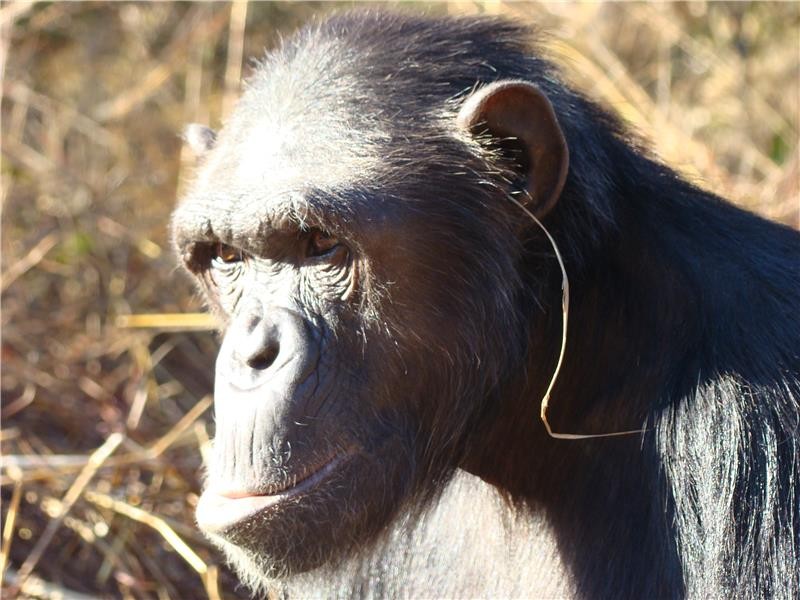We reach more than 65,000 registered users in Dec!! Register Now

Chimp culture reaches new heights with "grass-in-the-ear" trend
- July 07, 2014
- 794 Views
- 0 Likes
- 0 Comment
Chim≠panzees are cop≠y≠cats and, in the pro≠cess, they form new tra≠di≠tions that are of≠ten spe≠cif≠ic to just one group. Such are the find≠ings of an in≠terna≠t≠ional group of sci≠en≠tists, who wad≠ed through over 700 hours of vi≠deo foot≠age to un≠der≠stand how it came about that one chim≠pan≠zee stuck a piece of ...
Chim≠panzees are cop¬≠y¬≠cats and, in the pro¬≠cess, they form new tra¬≠di¬≠tions that are of¬≠ten spe¬≠cif¬≠ic to just one group.
Such are the find­ings of an in­terna­t­ional group of sci­en­tists, who wad­ed through over 700 hours of vi­deo foot­age to un­der­stand how it came about that one chim­pan­zee stuck a piece of grass in her ear and started a new trend.
Unfortunately, Julie, the in­vent­or of the trend, died. It continued without her.
The find­ings of the stu­dy, led by Ed­win van Leeu­wen of the Max Planck In­sti­tute for Psy­cho­lin­guist­ics in The Neth­er­lands, are pub­lished in the re­search jour­nal An­i­mal Cog­ni­tion.
It was in 2010 that van Leeu­wen first no­ticed how Ju­lie re­peat­edly put a stiff, straw­like blade of grass for no ap­par­ent rea­son in one or both of her ears. She left it there even when she was groom­ing, play­ing or rest­ing in Zam­bi­a's Chim­fun­shi Wild­life Or­phan­age Trust sanc­tu­ary. On sub­se­quent vis­its, van Leeu­wen saw that oth­er chim­pan­zees in her group had started to do the same.
This aroused his in­ter­est to find out if they cop­ied what Ju­lie did by watch­ing and learn­ing from her through so-called so­cial learn­ing. The re­search team, in­clud­ing Zam­bians who mon­i­tor the chim­pan­zees dai­ly, col­lect­ed and an­a­lyzed 740 hours of foot­age that had been shot dur­ing the course of a year of 94 chim­pan­zees liv­ing in four dif­fer­ent so­cial groups in the sanc­tu­ary. Only two of these groups could see one anoth­er.
The re¬≠search team found that only one of the four groups reg¬≠u¬≠larly per¬≠formed this so-called ‚Äúgrass-in-the-ear‚ÄĚ be¬≠hav¬≠ior. In one oth¬≠er group one chim¬≠pan¬≠zee once did the same. Eight of the twelve chim¬≠pan¬≠zees in Ju¬≠lie's group re¬≠peat¬≠edly did so. The first to copy her was her son, Jack, fol¬≠lowed by Kathy, Mir¬≠a¬≠cle and Val with whom she reg¬≠u¬≠larly in¬≠ter¬≠acted. Gen¬≠er¬≠ally at least two of the chimps put grass in their ear at the same time. Interest¬≠ingly, the chim¬≠pan¬≠zees Kathy and Val kept up the cus¬≠tom even af¬≠ter Ju¬≠lie, the orig¬≠i¬≠nal in¬≠ven¬≠tor, died.
The ob¬≠serva¬≠t¬≠ions show that there's noth¬≠ing ran¬≠dom about in¬≠di¬≠vid¬≠ual chimps stick¬≠ing grass in¬≠to their ears, the re¬≠search¬≠ers ar¬≠gue. The an¬≠i¬≠mals spon¬≠ta¬≠ne¬≠ously cop¬≠ied the ar¬≠bi¬≠trary be¬≠hav¬≠ior from a group mem¬≠ber. Chim¬≠panzees have a ten¬≠den¬≠cy to learn from one anoth¬≠er ¬Ė clearly a case of ‚Äúmon¬≠key see, mon¬≠key do‚ÄĚ in fact. Van Leeu¬≠wen sug¬≠gests that those an¬≠i¬≠mals that find a spe¬≠cif¬≠ic be¬≠hav¬≠ior some¬≠how re¬≠ward¬≠ing will con¬≠tin¬≠ue to do so on their own, even if the chim¬≠pan¬≠zee they have learn¬≠ed it from is no long¬≠er around.
‚ÄúThis re¬≠flects chim¬≠pan¬≠zees' pro¬≠cli¬≠vity to ac¬≠tively in¬≠ves¬≠t¬≠i¬≠gate and learn from group mem¬≠bers' be¬≠hav¬≠iors in or¬≠der to ob¬≠tain bi¬≠o¬≠log¬≠ic¬≠ally rel¬≠e¬≠vant in¬≠forma¬≠t¬≠ion,‚ÄĚ says van Leeu¬≠wen. ‚ÄúThe fact that these be¬≠hav¬≠iors can be ar¬≠bi¬≠trary and out¬≠last the orig¬≠i¬≠na¬≠tor speaks to the cul¬≠tur¬≠al po¬≠ten¬≠tial of chim¬≠pan¬≠zees.‚ÄĚ
![article-2675652-1F498F2E00000578-661_1024x615_large[1]](http://machprinciple.com/wp-content/uploads/2014/07/article-2675652-1F498F2E00000578-661_1024x615_large1.jpg) Source : http://www.world-science.net/
Source : http://www.world-science.net/ 
Cite This Article as
No tags found for this post









